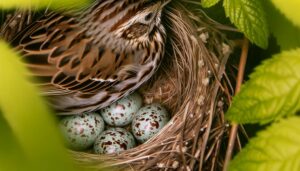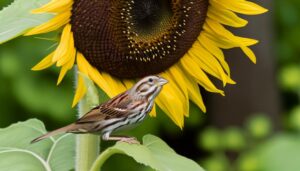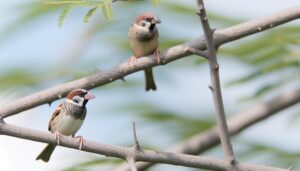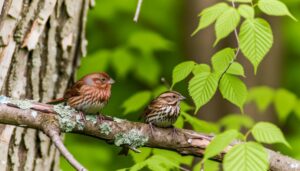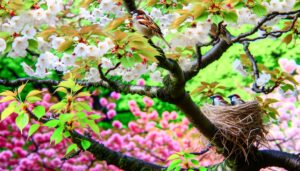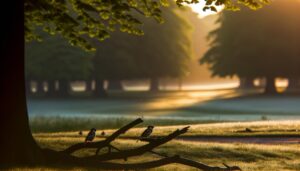5 Tips to Attract Song Sparrows to Your Garden
To attract song sparrows, one should create an inviting environment by providing various seeds like millet and sunflower and scattering them on the ground to mimic their natural foraging. Utilize platform feeders with ample perching space, placed in open areas near thick shrubs.
Fresh water sources such as shallow birdbaths with moving water sounds are crucial. Plant native vegetation, dense shrubs, and seed-producing plants to offer food and shelter.
Avoid pesticides to maintain their environment toxin-free and install predator guards to guarantee safety. These steps establish a sparrow-friendly habitat, encouraging frequent visits.
Discover more ways to enhance your garden for song sparrows.
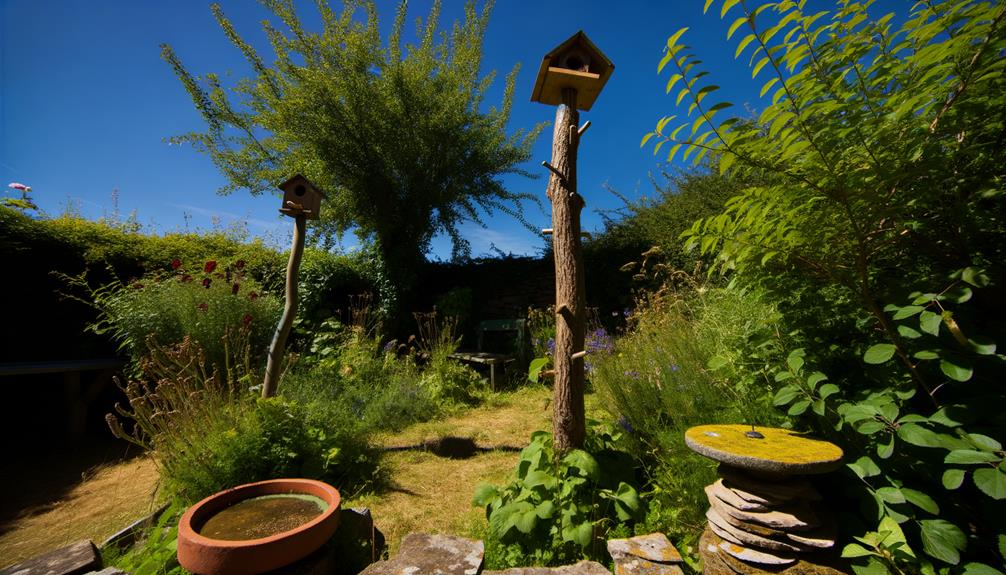
Key Takeaways
- Install platform feeders with ample perching space and scatter seeds on the ground to mimic natural feeding.
- Provide a mix of native seeds like coneflowers, asters, and sunflower seeds for diverse nutrition.
- Ensure fresh water sources with shallow birdbaths and regularly changing water to attract sparrows.
- Plant dense shrubs, berry-producing bushes, and native vegetation for cover, nesting sites, and food.
- Avoid pesticides and chemicals to ensure uncontaminated food sources and protect the local ecosystem.
Understand Song Sparrow Habits
Understanding song sparrow habits requires observing their feeding patterns, nesting behaviors, and vocalization characteristics. These small birds primarily feed on seeds, insects, and fruits. Observing them in their natural habitat, one can note their preference for foraging on the ground or low bushes.
Nesting occurs in dense shrubs or tall grasses, where females construct cup-shaped nests using grass and twigs. Vocalization is a critical aspect of their behavior; males are known for their complex and varied songs, which serve to attract mates and establish territory. They sing persistently during the breeding season, showcasing their adaptability and resilience.
Recognizing these habits provides valuable insights into creating a suitable environment to attract and support song sparrows.
Choose Ideal Bird Feeders
Selecting the right bird feeders for Song Sparrows requires attention to design preferences, such as open trays or tube feeders with perches.
Placement is important; feeders should be positioned in locations that offer both visibility and safety from predators.
Observations indicate that Song Sparrows are more likely to visit feeders situated near shrubs or low trees, which provide quick cover.
Feeder Design Preferences
To attract song sparrows effectively, bird feeders should feature a design that accommodates their preference for platform feeders with ample space for perching. Song sparrows are ground foragers by nature, so they're drawn to feeders that mimic their natural feeding habits.
Ideal feeders should be sturdy, with a broad, open surface that allows multiple birds to feed simultaneously without crowding. A mesh bottom is beneficial for drainage, preventing seed accumulation and spoilage. Additionally, the feeder should be elevated yet accessible, reducing the risk from ground predators.
Incorporating features like a roof can offer protection from the elements, ensuring that seeds remain dry and appealing. Such thoughtful design considerations will greatly enhance the chances of attracting these melodious visitors.
Placement and Visibility
Choosing the best placement for bird feeders is important in guaranteeing song sparrows can easily locate and access the food provided. Observational studies suggest placing feeders at varying heights, ranging from ground level to six feet.
Song sparrows often forage close to the ground, so ground feeders and low-hanging feeders are ideal. Visibility is essential; feeders should be placed in open areas with minimal obstructions. Additionally, positioning feeders near shrubs or small trees provides cover, helping sparrows feel secure from predators.
Avoid placing feeders too close to windows to prevent collisions. Regularly changing the feeder's location can also attract more birds by mimicking natural foraging conditions. This strategic placement guarantees that song sparrows thrive in a supportive environment.
Select the Right Seeds
When selecting seeds for attracting song sparrows, one should prioritize native seeds as they align with the birds' natural diet and habitat.
Additionally, providing a mix of seed varieties can cater to their diverse nutritional needs and preferences.
This approach increases the likelihood of observing healthy, vibrant song sparrows in the area.
Opt for Native Seeds
Selecting indigenous seeds plays a pivotal role in attracting song sparrows, as these birds have evolved to recognize and prefer the flora specific to their regional habitats. By offering indigenous seeds, one ensures that the nutritional needs of song sparrows are met, promoting their health and well-being. Indigenous seeds also support local ecosystems, providing food for other wildlife and contributing to biodiversity. Observations indicate that song sparrows are particularly drawn to seeds from plants such as coneflowers, asters, and goldenrods.
| Indigenous Plant | Preferred Seed Type |
|---|---|
| Coneflower | Echinacea seeds |
| Aster | Aster seeds |
| Goldenrod | Solidago seeds |
| Black-eyed Susan | Rudbeckia seeds |
Provide Mixed Varieties
Blending a variety of seeds from different native plants guarantees song sparrows receive a balanced diet that caters to their diverse nutritional needs.
Observations reveal that song sparrows favor a mix of millet, sunflower seeds, and cracked corn. Each seed type offers distinct nutritional benefits, ensuring the birds get essential proteins, fats, and carbohydrates.
For instance, sunflower seeds provide high-fat content essential for energy, especially in colder months, while millet offers protein for growth and maintenance.
Regularly replenishing feeders with these mixed varieties can significantly increase the likelihood of attracting song sparrows. It's also beneficial to scatter seeds on the ground, mimicking their natural foraging behavior.
This strategic approach supports the birds' overall health and encourages frequent visits.
Provide Fresh Water Sources
Ensuring a consistent supply of fresh water is pivotal for attracting song sparrows to your garden. These birds require clean water for drinking and bathing, which helps them maintain healthy feathers and hydration.
Installing a shallow birdbath, no deeper than two inches, can cater to their needs. Position the birdbath in a shaded area to keep the water cool and prevent rapid evaporation. Regularly changing the water reduces the risk of disease and algae growth.
Adding a small fountain or dripper can create a gentle flow, attracting song sparrows with the sound of moving water. Observations indicate that providing such resources significantly boosts the likelihood of these birds frequenting and nesting in your garden.
Plant Native Vegetation
In addition to providing water, planting native vegetation creates an inviting habitat that meets the dietary and shelter needs of song sparrows. Native plants offer essential resources that non-native species often lack. Observations reveal that song sparrows thrive in areas with abundant native flora.
To create such an environment, consider the following:
- Dense Shrubs: Provide cover and nesting sites, essential for protection against predators.
- Seed-Producing Plants: Offer a reliable food source, especially in winter when insects are scarce.
- Flowering Plants: Attract insects, a primary diet component for song sparrows.
- Berry-Producing Bushes: Supply high-energy food, especially during the breeding season.
Create Safe Nesting Areas
To create safe nesting areas for song sparrows, one should strategically position dense foliage and thorny bushes to deter predators and provide secure nesting sites. Dense vegetation like brambles, hawthorn, and evergreen shrubs offer ideal protection, making it challenging for predators such as cats or larger birds to access nests.
Observations indicate that song sparrows prefer nesting sites that are low to the ground yet well-concealed. Ensuring a mix of plant heights can create layered protection, enhancing the habitat's safety.
Maintaining a natural, cluttered landscape with leaf litter and twigs, which sparrows use to build their nests, is crucial. By providing a variety of plant structures, one can greatly increase the likelihood of attracting these birds to nest safely.
Offer Shelter and Protection
By incorporating dense vegetation for nesting, one can also offer shelter and protection to song sparrows by providing brush piles, hedgerows, and birdhouses strategically placed throughout the habitat. These elements create a safe environment, shielding the birds from predators and harsh weather.
For best results, consider the following:
- Brush piles: Stack branches and twigs to form protective mounds where sparrows can hide.
- Hedgerows: Plant dense shrubs and bushes in a row to create natural barriers.
- Birdhouses: Install small, enclosed nests at varying heights to accommodate different preferences.
- Evergreen trees: Use these to provide year-round cover and roosting spots.
These practices foster a secure habitat, encouraging song sparrows to thrive.
Avoid Pesticides and Chemicals
Eliminating the use of pesticides and chemicals guarantees song sparrows remain healthy and their food sources are uncontaminated.
Pesticides can reduce insect populations, a primary food source for song sparrows, leading to nutritional deficiencies. Chemical residues on plants may also harm the birds directly, impacting their overall health and reproductive success.
Observations indicate that exposure to these substances can disrupt the delicate balance of local ecosystems, affecting not just the sparrows but other wildlife and beneficial insects as well.
Keep Cats and Predators Away
Securing song sparrows thrive involves taking proactive measures to keep cats and other predators at bay, as these threats can significantly impact their populations. Observational studies have shown that predation is a major factor in the decline of song sparrows.
To protect these birds, consider implementing the following strategies:
- Install predator guards: Place baffles on bird feeder poles and nest boxes to prevent climbing predators.
- Create safe zones: Designate areas in the yard where cats aren't allowed, using fencing or other barriers.
- Use motion-activated deterrents: Devices that emit sounds or water sprays can discourage predators without harming them.
- Provide dense vegetation: Plant shrubs and bushes to offer cover and nesting sites away from predators.
These methods will help secure a safer environment for song sparrows.
Conclusion
Coincidentally, by understanding song sparrow habits and offering ideal feeders, the backyard becomes a haven for these melodious birds. Selecting the right seeds and providing fresh water sources maximizes their stay.
Native vegetation and safe nesting areas invite them to linger, while shelter and protection keep them safe. By avoiding pesticides and deterring predators, one creates a prime environment.
Observing these lively creatures, it's evident that thoughtful preparation leads to a flourishing song sparrow sanctuary.

